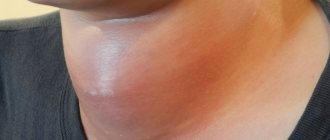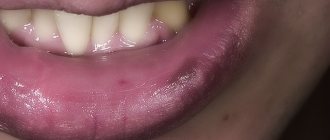If something hurts somewhere, you should not endure the pain, but go to the doctor. If your neck hurts, radiates under your jaw, and in general the pain causes serious discomfort, then you can contact one of these specialists - a surgeon, neurologist
, dentist,
otolaryngologist
- or make an appointment with
a therapist
, who will refer you to the right doctor. An accurate diagnosis cannot be made based on the location and nature of the pain alone. Additional examinations may be required to help find the right solution and relieve you of painful discomfort. Pain in the neck and jaw occurs for a number of reasons, which can be divided into mechanical effects and acquired diseases and pathologies. If such pain accompanies you constantly, then it cannot be ignored. The lack of well-chosen treatment can result in a whole list of unpleasant consequences.
Causes of enlarged submandibular lymph nodes
Two groups of 6-10 lymph nodes, located symmetrically on the right and left in the tissue behind the arch of the lower jaw, collect lymph from the salivary glands, tonsils, palate, tongue, cheeks, nose, jaws and lips. Therefore, their increase is observed when these organs and tissues are damaged. Lymphoid hyperplasia is provoked by infections of the nasopharynx and oropharynx, dental pathology, local tumor processes, and may indicate the development of lymphoma and lymphogranulomatosis. Less commonly, damage to the lymph nodes is complicated by eye diseases - dacryoadenitis, stye on the eyelid.
ARVI
Infection with pneumotropic viruses is a common and obvious cause of benign lymphadenopathy, in which the submandibular and cervical lymph nodes simultaneously enlarge. Changes in the lymphoid tissue through which lymph from the oropharynx and nasopharynx are filtered are more noticeable with the development of ARVI during pregnancy and in children. In the first case, this is due to a physiological decrease in immunity to reduce the threat of miscarriage, in the second - with the age-related development of protective mechanisms.
Submandibular lymphadenopathy is more often observed with adenovirus infection, parainfluenza, infection with rhinoviruses or an association of viral pathogens. Typically, the lymphatic reaction is preceded by so-called catarrhal phenomena - runny nose, sore throat, pain when swallowing, dry cough, lacrimation. The temperature often rises, and to high (febrile) numbers - from 38 ° C and above. Characterized by moderate asthenia - weakness, weakness, fatigue. Muscle and joint pain is possible.
With ARVI, the skin over the submandibular lymph nodes has a natural color. The increase in lymphoid formations is slight (slightly more than 1 cm). The lymph nodes are compacted, but not rocky, have a smooth surface, and are mobile. During palpation, pain may be detected. As a rule, there is a symmetrical increase in nodes in both submandibular groups, which is associated with the spread of viral particles through the lymphatic system. As the infectious process subsides, the normal size and density of the submandibular lymph nodes are restored.
Sore throat and chronic tonsillitis
The second most common cause of enlarged submandibular lymph nodes is an infectious-inflammatory lesion of the palatine tonsils. Lymphadenopathy develops in both acute and chronic processes. With angina, the lymph nodes enlarge within 1-2 days from the onset of inflammation, in some cases reaching a diameter of up to 2 cm. The symptom occurs against the background of severe intoxication, an increase in temperature to 38-40 ° C, intense pain in the throat with painful swallowing and irradiation to the ears, severe headaches, muscle and joint pain.
With unilateral acute tonsillitis, the jaw lymph nodes on the corresponding side react more often; with bilateral acute tonsillitis, a lymphoid reaction is detected on the left and right. Often the cervical lymphatic groups are involved in the process. To the touch, the nodes are dense, painful, and mobile. The increase in size can persist for 1-2 weeks after the underlying disease subsides, then the diameter of the submandibular lymph nodes gradually decreases to normal, if the process has not become chronic.
Chronic tonsillitis is characterized by a symmetrical moderate enlargement of the nodes of both mandibular groups without involvement of the lymphatic formations of the neck. The pain is less pronounced. In a simple form of chronic inflammation of the tonsils, prolonged grade I lymphadenopathy often becomes the most noticeable manifestation of the disease. In patients with the toxic-allergic variant of tonsillitis, symptoms of damage to the tonsils are expressed with pain and sore throat, discomfort when swallowing, and bad breath. A persistent low-grade fever often persists.
Other infectious diseases
Damage to the submandibular lymph nodes is determined by a number of systemic infections, bacterial, viral and fungal processes affecting the respiratory system and salivary glands. The reaction of the submandibular nodes is due to the performance of a barrier function when pathogens enter the lymphatic system from the mucous membranes of the nose, oral cavity, and head organs. Mandibular lymphadenopathy manifests itself in such general and local infectious diseases as:
- Infectious mononucleosis
. The submandibular nodes are the first to respond to the introduction of the Epstein-Barr virus. Their increase is caused by lymphoid hyperplasia, primarily by the reaction of B-lymphocytes specifically affected by viral particles. At the initial stages of the pathological process, in addition to a local lymphoid reaction, low-grade fever is noted, a sore throat, and nasal congestion are felt. Later, the disease manifests itself as sore throat, generalized enlargement of the lymph nodes, liver and spleen. - Herpetic infection
. Hyperplasia of the lymph nodes of the submandibular groups is detected in herpetic stomatitis. Characterized by increased temperature, increased secretion of saliva, erosive and aphthous lesions of the oral mucosa. In addition to hyperplasia, inflammation of the lymphoid tissue with the development of mandibular lymphadenitis is possible. Kaposi's eczema herpetiformis is even more severe, in which the occipital and cervical lymph nodes are also affected, and vesicular, pustular, and erosive skin lesions are present. - Cytomegaly (CMVI)
. The involvement of the submandibular lymph nodes is due to the sensitivity of cytomegaloviruses to the ductal epithelium of the salivary glands with the occurrence of parotid sialadenitis as one of the pathognomonic signs of the disease. Submandibular lymphadenopathy is combined with the neck, high temperature, weakness, headache, and other signs of intoxication are determined. A clear clinical picture is observed in 4-5% of patients, while the manifestation of cytomegalovirus infection is more often observed in pregnant women. - Respiratory mycoplasmosis
. Moderate enlargement of the submandibular lymph nodes is characteristic of mycoplasma infections of the upper respiratory tract. Possible simultaneous damage to the cervical lymph nodes. Lymphadenopathy is preceded by a short period of catarrhal symptoms - a painful dry cough, runny nose with copious mucus, sore throat, injection of scleral vessels. In the future, respiratory mycoplasmosis can spread downward to the trachea, bronchi, and lungs. - Cat scratch disease
. The submandibular nodes are affected when a cat bite or scratch is localized in the facial area. Lymphadenopathy is quickly complicated by submandibular lymphadenitis. The combination of a lymphoid reaction with a reddish nodule (papule), and then an abscess (pustule) at the site of skin damage is pathognomonic. The inflamed lymph nodes are enlarged to 1.5-2 cm and are sharply painful. Lymphadenitis persists for up to 2 months and is accompanied by febrile temperature, weakness, fatigue, myalgia, and headache. - Scrofuloderma
. In lymphogenous colliquative tuberculosis of the skin, the leading symptom is the formation of dense reddish-purple nodes (tuberculous granulomas) in the area of the submandibular and cervical lymph nodes, from which dissemination of Koch bacilli occurs. An increase in lymphatic formations corresponds to lymphadenopathy I, less often II degree and complements suppurating subcutaneous tubercles, which break through fistulas and are slowly replaced by coarse scar tissue.
Dental pathology
The submandibular nodes serve as the main collectors of lymph from organs located in the oral cavity. Therefore, they are among the first to respond to any inflammation of the oral mucosa, dental tissue, upper and lower jaws. The reason for the enlargement of the lymph nodes is protective hyperplasia of the lymphoid tissue in response to the presence and proliferation of the pathogen, and in more severe cases, with lymphogenous spread of the process, infiltration of the stroma with inflammatory elements.
A moderately pronounced increase in the nodes of the submandibular group on the side of the pathology is observed in periodontitis, alveolitis, and periostitis of the jaw. Typically, lymph nodes become hyperplastic due to pain in the projection of the lesion, putrid odor from the mouth, low-grade or febrile fever, weakness, weakness, and other manifestations of intoxication. Submandibular lymphadenitis, which developed against the background of bright redness, multiple ulcerations, dirty gray plaque and foci of necrosis of the oral mucosa, is a sign of ulcerative necrotic stomatitis.
Malignant neoplasms
Lymphogenic metastases in the submandibular nodes are found in patients with late stages of oncological diseases of the head organs. A combination of mandibular lymphadenopathy with an increase in nodes of other groups is typical: for lip cancer - with mental and jugular nodes, for tongue cancer - with mental and occipital nodes, for cancer of the lower jaw - with cervical nodes, and for eye melanoma - with cervical and parotid nodes. Compaction and enlargement of the submandibular nodes is an important sign of malignant tumors of the salivary glands.
The detection of altered lymphatic formations usually indicates that the oncological process is old (early metastasis is typical only for tumors of the lower jaw and melanomas). The diameter of the nodes can reach 2 cm. To the touch they are defined as hard, rocky, sometimes have a bumpy surface, and are fused together with each other and the surrounding skin into a single conglomerate. Lymphadenopathy is preceded by pathognomonic signs of the tumor process - growths and ulcerations of the skin, mucous membranes, dense infiltrates, local pain, limitation of movements, etc.
Kinds
The disease can be acute or chronic. The second type is much more difficult to eliminate, since with it the damage to the mucous membrane is more severe and deep.
Also, depending on the clinical picture of the disease, lateral pharyngitis is divided into three types.
1. Chronic lateral pharyngitis, atrophic. During the disease, the mucous membrane becomes thinner, and the lymphoid tissue is partially replaced by connective tissue. The mucous membrane is hidden by epithelial tissues, some of which are prone to keratinization and peeling. This type of disease is difficult to treat. In advanced forms, only maintenance therapy is possible, which minimizes discomfort in the throat and reduces the likelihood of complications.
2. Subatrophic. It is often called not an independent form, but the first stage of atrophic lateral pharyngitis. The patient experiences diffuse damage to the pharyngeal mucosa, against which tissue atrophy develops. With such a lesion, treatment can completely solve the problem.
3. Hypertrophic. Against the background of pathology, the mucous membrane becomes loose and thickened. There is also a dilation of the vessels of the mucous membrane and an increase and thickening of the lymphoid nodules.
Depending on what type of problem is diagnosed, the treatment of the pathology is selected. The sooner a patient seeks medical help, the higher the likelihood that the disorder will be completely eliminated.
Survey
Most often, patients who have identified enlarged lymph nodes in the submandibular area without other noticeable clinical manifestations turn to hematologists. In case of obvious pathology on the part of the head organs or probable signs of an infectious process (fever, skin rash, enlarged spleen, liver), doctors of the relevant profile are involved in organizing their examination. The diagnostic search is aimed both at determining the root causes of lymphadenopathy and at assessing the condition of the affected nodes. The most informative ones are:
- Ultrasonography
. Ultrasound of lymph nodes is used to quickly determine the size, shape, location, and structure of lymphoid formations. The method makes it possible to clarify the involvement of surrounding tissues in the process, as well as to differentiate lymphadenopathy from lesions of the salivary glands. - Radiodiagnostics
. In order to determine the characteristics of lymph flow in the affected area, lymphography using X-ray contrast is prescribed. In more complex diagnostic cases, CT scan of the lymph nodes is indicated. A valuable non-invasive diagnostic method is MRI of lymph nodes. - Biopsy
. Sampling of lymphoid tissue for histological examination is an accurate way to detect inflammatory processes, fibrous degeneration of the lymph node, and the degree of its damage by the oncological process. Biopsy of the lymph nodes of the submandibular zone is performed by puncture and open method. - Lab tests
. The examination begins with a general blood test, which reveals inflammatory changes and possible neoplastic changes in the composition of cellular elements. To confirm the infectious nature of lymphadenopathy, culture of a throat smear, RIF, ELISA, and PCR diagnostics are performed. - Special instrumental diagnostics
. To establish the cause of enlarged submandibular lymph nodes, pharyngoscopy, rhinoscopy, and otoscopy are performed. To exclude ophthalmological diseases, an examination of the eye structures is indicated. In case of possible dental pathology, radiography of teeth and jaws and other instrumental studies are used.
Ultrasound examination of the submandibular lymph nodes
During pregnancy
During the period when a woman is carrying a child, against the background of hormonal changes, a sharp decrease in immunity occurs. This is a normal and necessary process that ensures the preservation of pregnancy, since without it the body’s natural protective barrier will recognize the fetus as a foreign object that needs to be removed from the body. For this reason, various viral and bacterial throat infections are becoming a fairly common problem. For some women, classic or lateral pharyngitis is a constant companion of pregnancy.
Since any inflammation poses a danger to the fetus, treatment should be carried out from the first symptoms. Self-medication is strictly prohibited, as it poses a serious danger and can cause serious consequences for the unborn child. In the early stages, due to general intoxication, there is a risk of miscarriage, and in the later stages, there is a risk of premature birth. It can also cause disturbances in the development of the child, both physical and mental.
Symptomatic therapy
Before prescribing special treatment, rinsing with antiseptic solutions is effective in order to more quickly restore the size and density of the submandibular lymph nodes in case of ARVI, sore throat, and other inflammatory processes in the oral cavity. In the presence of combat syndrome, it is possible to take analgesics. In other cases, therapy is selected only after the causes of the condition have been established. The combination of lymphadenopathy with fever, rapid deterioration in health, headache, or detection of tumor formations in the head area is an indication for emergency medical attention.
In children
In childhood, the problem often appears and poses a threat, especially for children under 3 years of age. In them, due to the structural features of the nasopharynx, even mild swelling can cause suffocation. Also, intoxication at an early age is much more difficult to tolerate, which is why the child may develop convulsive seizures. With a significant increase in temperature due to pharyngitis, hospitalization is most often indicated for children under 3 years of age.
Pain, which is much stronger with lateral inflammation than with damage to the posterior wall, leads to loss of appetite. In some cases, this is the first symptom of the disease, a few hours after which an increase in temperature and other manifestations of pathology are observed.
How to get an eversion carotid endarterectomy service (removal of carotid artery plaques)
Indications for surgical treatment of atherosclerosis of the internal carotid arteries are determined by a cardiovascular surgeon; however, to successfully perform the operation and minimize the risk of complications, coordinated interaction between a neurologist, cardiologist, and anesthesiologist is necessary. Our institution employs just such a team of professionals who are ready to help every patient in the fight against cardiovascular diseases. By making an appointment with a cardiovascular surgeon at the clinic, you will receive comprehensive information about the methods of modern diagnosis and treatment of diseases of the carotid arteries, determine the need and timing of surgical intervention. The modern technologies used and the experience of our specialists will help in getting rid of narrowing of the carotid arteries, preventing strokes and maintaining an active and fulfilling life.
Treatment
Conservative therapy
The list of therapeutic measures is determined by the nature of the pathology:
- Fractures of the lower jaw
. A linear fracture of the body without displacement is an indication for double-jaw wire splinting. The patient is recommended a gentle diet. In the first days, painkillers are prescribed; for open injuries, antibiotics are used. - Purulent processes
. The skin around the outbreak is treated with disinfectants and alcohol solutions. Antibacterial drugs are selected taking into account the sensitivity of the pathogen. The treatment regimen includes anti-inflammatory drugs, immunomodulators, immunostimulants, and vitamin complexes. - Neuralgia
. The basis of treatment is anticonvulsant medications, which, to increase effectiveness, are combined with medications to improve microcirculation, antispasmodics, antihistamines and therapeutic blockades. - Dental diseases
. Host local events. According to indications, it is recommended to take antibiotics and analgesics. - Atypical prosopalgia
. Tricyclic depressants and anticonvulsants (both separately and as part of complex therapy) provide good results. For intense pain, botulinum toxin is injected to temporarily reduce sensitivity. - Stylohyoid syndrome
. NSAIDs, sedatives, blockades with corticosteroids and local anesthetics, ultraphonophoresis with hydrocortisone are prescribed.
Prevention
A variety of preventive measures will help prevent the disease from exacerbating and returning. First of all, it is maintaining a healthy lifestyle. Engage in moderate physical activity and avoid eating unhealthy foods in excess. If you periodically have pain in your neck under your chin, then do not forget to visit a doctor and consult with him before you feel another pain syndrome. Stop smoking or reduce the number of cigarettes you smoke per day. Try not to abuse alcohol or take medications not directly prescribed by your doctor.











